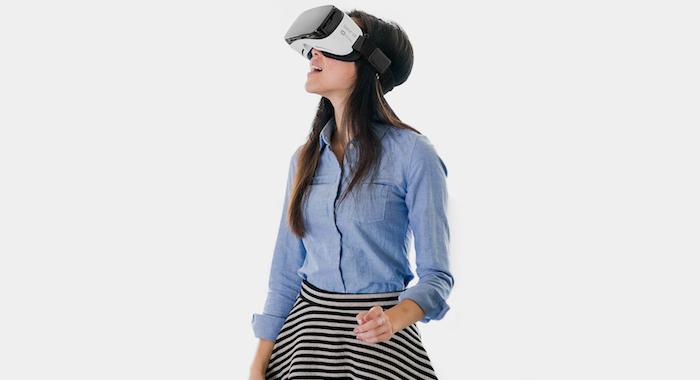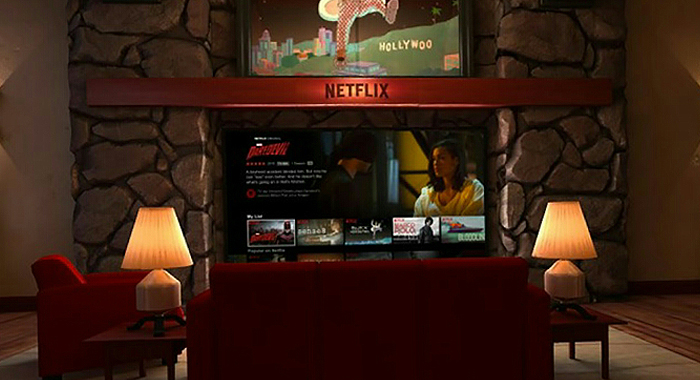
Thanks to falling prices and consumer-conscious companies like Vizio, ownership of an inexpensive, large, relatively feature-rich TV has become accessible to more Americans in recent years. But what if I told you that your next home entertainment experience will be much, much smaller — but actually feel bigger? Forget 4K, forget 70-inch OLEDs; it’s time you took a look at virtual reality.
It’s all but impossible to describe what VR “looks” like. It’s a reality you must experience for yourself. But for many people, once is enough to leave you immediately hooked. It’s immersive, it’s fun, it’s escapist entertainment at its finest — but much like the iPad before it, VR is a product many people think they don’t need or want until they try it. That’s why Samsung has been pretty savvy about making sure the barrier to entry is pretty low when it comes to their Gear VR headset by bundling it with purchase of their S7 handsets. And now Alcatel — who put out one of my top pick budget phones in 2015 — is also bundling a VR headset with their new Idol4S, so we may see another compelling avenue for buyers to get their feet wet.
There are other pricier headsets on the market (such as the Oculus Rift, HTC Vive, and Sony’s Playstation VR) for those curious to check out VR’s capabilities, but the cost is what may keep all but the most aggressive early adopters from really checking out how VR can amp up their home entertainment. With that in mind, I’ll be looking at smartphone-based virtual reality offerings, courtesy of a Samsung Gear VR provided for me by Verizon.
One major barrier keeping people from getting into VR is that they don’t know just how much programming is actually available, but there is definitely an audience already consuming content on the platform. The Netflix VR app has been highly rated over 15,000 times with almost 600 written app reviews. Discovery Channel’s app has 900 ratings with 100 written reviews, and one of VR’s premiere experiences, Notes on Blindness, boasts roughly 7,700 ratings with 183 reviews. But that isn’t all. There are movie rentals and downloads, YouTube videos, DVD/BluRay extras, and much more.

When Samsung brought the Gear VR to market, they partnered with Oculus, makers of the Rift VR headset. The Rift, which had already been on the market, is a larger, more powerful version of the Gear VR headset, and already had a wealth of content available for its platform. This gave Samsung a foot in the door with a relatively mature product right out of the gate. Once you download the necessary apps onto your phone, you’re ready to watch everything from Netflix to curated streams of video from content providers like Vice, HuffPost, CNN, Good Morning America, Nat Geo, and more. You can even rent or download movies.
“Why do I need this in my life?” you might be thinking. The quick answer: you don’t. But once you’ve tried it, I’m betting you’ll want it.
Why would you want it? It’s an easy way to watch movies, TV, and short-form programming in a manner that isn’t disruptive to those around you. Laying in bed next to a sleeping significant other? Sharing a space with roommates and want to watch something late? VR puts you in your own world and keeps others out unless you decide to let them in via some social sharing functions. Can’t afford a large TV, but you can afford $99 for a Gear VR? This may be the right option for you.
Beyond the easy answers, on a deeper level, VR’s immersion allows you to truly be whisked away to foreign lands and experience things to a previously impossible degree. One of the videos on the Oculus Store is called Valen’s Reef, and it allows you to explore the Great Barrier Reef through the eyes of Valen and his son. They’re locals from Papua New Guinea who work with conservationists to keep the natural habitat of the reef intact for future generations to enjoy. Scuba diving with Valen and having a 360-degree view of the coral, fish, sharks, and giant manta is a compelling experience — not to mention a great teaching tool for children.
Speaking of compelling, one of the most lauded experiences in the Oculus store is Notes on Blindness. This VR experience, which dovetails with an accompanying documentary, combines the real cassette recordings of a man who went blind and journaled his experiences. The filmmakers paired those recordings with visuals (think the “vision” sequences in Ben Affleck’s Daredevil), and an immersive soundscape. You’re listening to the man, in his own words, describe what he’s going through as he explores his newly darkened world; it’s so layered and nuanced that it’s impossible not to connect with what he’s going through. It’s said that people who read books tend to be more empathetic because through books they experience other people’s worlds — I think VR is the next frontier for expanding the imagination in a similar manner.

Notes on Blindness
Going through the more mainstream options, you can watch your Netflix queue through the VR, and in order to give you the TV experience, Netflix has created a virtual living room with a big screen TV. The room gets brighter or darkens based on what’s going on onscreen. There are even magazines on a virtual coffee table. The only caveat to watching in this fashion is that you must be sitting upright the whole time. You can’t reorient the screen so that you can lay down in your bed — or wherever — and watch Netflix through the Gear VR.
Watching purchased and rented content from the Oculus Store gives you more options for your virtual environment. You can be in a movie theater, on the moon, or other locations — like my personal favorite, the Void. In this environment, there is no “environment” — just a large screen in front of you and black all around. While writing this column, I decided to check out one of the 3D movie options, Gods of Brit… er, I mean, Gods of Egypt. Matters of quality aside, the movie presented quite well in VR — the images were clear and vibrant with only a very slight pixelation that most people probably won’t notice. The 3D was layered and immersive. The only caveat to the viewing experience with any of the content on the Gear VR is that, out at the edges of the picture frame, you may notice a slight blurring. It isn’t disruptive, but the images are sharpest at the center of the screen.
The sound, through the headphones I was using, was robust and had pleasing separation — a lot of which has to do with the fact that the Galaxy Note 5 has a great screen and solid sound output through the headphone jack. I’ve also had the opportunity to watch VR content through Alcatel’s new Idol4S, and though it’s actually quite phenomenal at the price point, there’s a noticeable difference in the visual quality. To be fair, the Idol VR sits somewhere between Google Cardboard and the Gear VR in terms of technology — kind of a more accessible middle ground. The Gear VR experience is rather polished, making pausing or stopping, getting into and out of content, a breeze. The device has a touch-sensitive body on its right side, which allows you to navigate your virtual reality with relative ease. There’s also a “Back” button right above the touch sensitive area.

Netflix’s Virtual Living Room
Is today’s mobile VR a perfect experience? No. It’s still maturing, and battery life is definitely a concern if you’re away from an outlet. If you sit for a long movie like Saving Private Ryan, you’re going to take a hit, and you may find yourself low on juice when it comes to actually using your phone as, well, a phone. So you’ll have to tap that battery bank once you’re finished with your entertainment. If you’re near an outlet, or on a long flight with your power bank, no fear! The Gear VR can be plugged in via microUSB. This is where the pricier VR headsets differ: they stay plugged into power, so no worries about battery life. But let’s keep in mind, you’re actually experiencing virtual reality through a smartphone. Let that sink in for a minute: the hardware needed to power your experience fits in your pocket.
All that said, is mobile VR worth getting into now? At the price point for the Gear VR or Alcatel’s new VR headsets, yes. Samsung even bundles the Gear VR free with a handset purchase from time to time, so that’s a no-brainer.
There’s so much more to get into where VR is concerned, and this article is only the tip of the iceberg — in fact, we hear the Olympics may be doing quite a bit of experimenting with VR coverage. Keep it locked right here on Rotten Tomatoes, as we’ll have more in the coming months as we take a look at other options and what they add to your viewing experience.
Tshaka Armstrong is a huge nerd and activist who also writes for foxla.com and his own site, tshakaexplainsitall.com, where he talks about food, bearding properly, tech, family, and equality.
Follow Tshaka on Twitter: @tshakaarmstrong